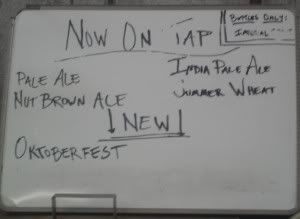 (This post is part of an assignment for the class I am taking, Writing for Digital Media at the School of Journalism and Mass Communication, University of North Carolina at Chapel Hill. This week, I liveblogged an event. I chose to cover the brewery tour at Carolina Brewing Company in Holly Springs, which occurs every Saturday at 1pm.)
(This post is part of an assignment for the class I am taking, Writing for Digital Media at the School of Journalism and Mass Communication, University of North Carolina at Chapel Hill. This week, I liveblogged an event. I chose to cover the brewery tour at Carolina Brewing Company in Holly Springs, which occurs every Saturday at 1pm.)
By Marcie Barnes
12:44 - I'm in the parking lot, have seen at least a dozen people enter already, and I was afraid there wouldn't be much of a crowd on State Fair weekend. The facade is quite unassuming.
12:47 - An announcement in the lobby - beer samples before the tour, and I need to have my ID ready.
12:51 - Waiting in a long line for beer, some happy jazz/swing music is playing overhead. Sign near serving area reads: Now On Tap: Pale Ale, Nut Brown Ale, India Pale Ale, Summer Wheat, and NEW Oktoberfest. I think I'll try Oktoberfest, it only seems fitting.
1:07 - Tour still not started, people still pouring in and waiting in a long line for beer. Many are going back in the line for seconds (or thirds, or fourths).
1:19 - Taps are off. Music is off. John, who is one of the three partners, starts the tour. They have only one employee, and do all the work themselves up to the point of distribution. The brewery is 13 years old. The Pale Ale was their first beer, and it is brewed year-round along with the Nut Brown and India Pale Ale. They have a winter porter coming out in November, and there are many other seasonal beers. They have a six-county distribution area.
1:28 - John is passing around barley and hops for us to see/smell. He explains how each affects the bitterness (hops), darkness (roast of the barley), sweetness (barley), etc. The Oktoberfest brew has the highest alcohol content at 5.7% which is related to the fact that it uses more barley, which produces more sugar for the yeast to convert to alcohol (and carbon dioxide).
1:31 - The barley sample comes my way. It has a nice, fresh, sweet smell. The hops sample was neither nice nor sweet smelling. The girl in front of me recoiled at the smell. I can only describe it as something unpleasantly pungent, to be nice. Now I know why I don't like a lot of hops in my beer, besides the fact that I don't like bitter.
1:33 - A comment from the audience is about rice and corn being used in beermaking. John describes how the big national breweries use these ingredients to make a light, cheap beer. Their brewery uses only (Holly Springs tap) water, barley, hops, and yeast. They use a different kind of yeast for the ales as they do for the lagers.
1:35 - He tells how they got started. Three friends were homebrewing for a long time and one of them eventually took an apprenticeship at a brewery to "learn the ropes". They moved to NC specifically to open the brewery after looking at demographics and noticing a deficiency in local breweries in the area. Someone asks him what beers he likes besides his own and he says: Sierra Nevada, Anchor Steam, and Highland (out of Asheville).
1:37 - He gets into the specifics of the recipe: grain is cracked, mixed with warm water, and steeped, which makes mash. Liquid is drawn out, leftover grain is given to a local farmer to feed his cattle. Liquid is boiled for 90 minutes, hops are added. Liquid is cooled rapidly and pumped to fermentation tanks. Whole process takes six hours. The two large tanks hold 2500 gallons of beer when full. Yeast added here in the big tanks. When it runs out of sugar to convert, it goes dormant, and they reclaim it and reuse it again.
1:42 - Once beer is done here, it is filtered through a system and sent to last holding tank, where it ages for three (ale) to six (lager) weeks. Another tourist asks about dry hopping. He says they only do that sometimes, like with a recent Thanksgiving lager. I don't have a clue what dry hopping is.
1:44 - He says they do not use any preservatives and do not pasteurize their bottles. I am happy to hear that. I thought there was some sort of government-imposed law about that with commercial bottling, but apparently not. It does shorten the shelf life compared to other beers, but beer is not meant to sit on the shelf like, perhaps, wine. Pasteurization and preservatives would compromise some of the healthy benefits of beer.
1:45 - We move closer to the bottling/kegging area. He's explaining the bottling process. Would be cool to see the machine running, but I imagine that would be logistically difficult. Machine bottles 100 bottles per minute, they only run it a couple days a week.
1:48 - He says he's wrapping up, turning taps back on. Says he'll leave them on maybe until 3:30 if we are "good".
1:56 - I finally make it back to the taps. Ask John if I can stay here and have a small sample of each, he says sure. The Summer Wheat doesn't really remind me of wheat, but I can definitely taste the hops. It's much more bitter than the Oktoberfest. I love the back of John's shirt: "All it takes is a liver and a dream".
2:02 - India Pale sample - Their website says it's the most highly hopped, and I can tell. It's so bitter it tastes metallic to me. Very crisp, though. The "bar" is situated at the end of a giant room-sized walk in cooler. The taps are literally drilled into the side of the cooler. Tourists are jovial and polite in the requests for their favorite flavor of free brew.
2:12 - Pale Ale sample - Doesn't smell as hopsy. I can actually taste more yeast in this one, which I like. Still too bitter for me, but I know a lot of people like it that way!
2:20 - Stout sample - this was dubbed "hidden stout" because there was no tap handle and the "bartender" didn't know it was there at first. This was a good one to end with because it smelled like Kahlua! I don't see anything about it on their website, and I wonder if this is the Winter brew that is coming out soon? Anyway, it's definitely heavy, but tasty. Has a sweet syrupy taste combined with the expected bitter hop flavor.
2:28 - Asked if this was a large group for them, and got the answer that no, it's a small group. He estimated about 100 people today, and says he's seen up to 300 come in! Wow.
Later Notes: Due to the popularity of this event, I recommend arriving early and getting a place at the front of the line. And bring a designated driver, too. This is a great way to spend a Saturday afternoon, learning about the brewing process and sampling some great, fresh, local beer. And it's a great way to support your local economy as well. There are also health benefits to beer not widely discussed in mainstream media the way those of wine have been (although I disagree with the part in the above linked article that says mainstream beer is as good as a microbrew, due to the fact that they -- mainstream -- use cheaper, lighter grains like rice and corn, so "equally high-quality ingredients" doesn't ring true.)
For readers outside of NC, please go tour a local brewery in your area!


































